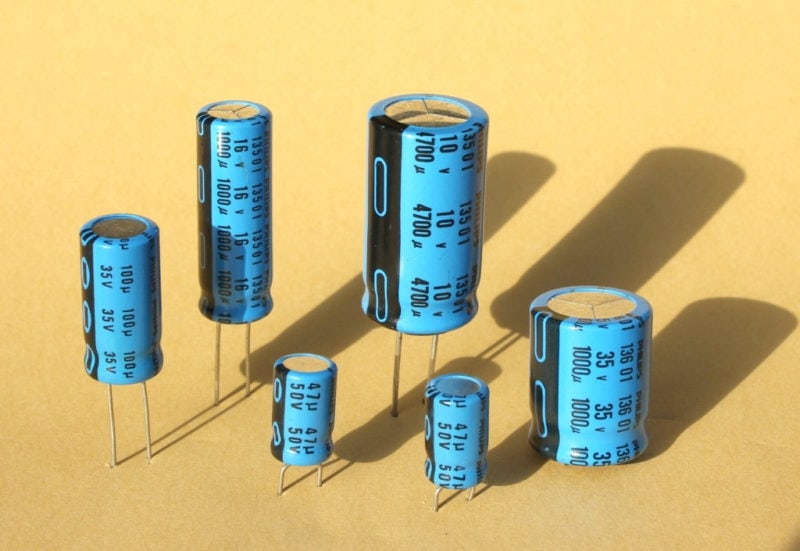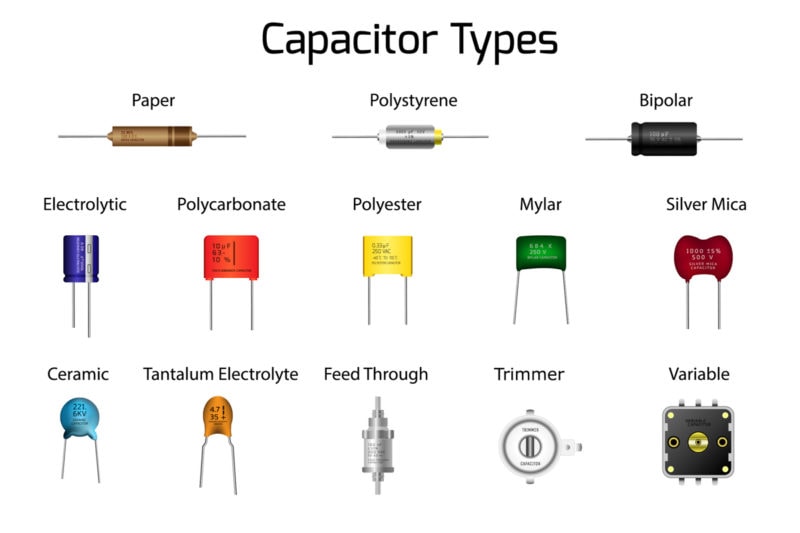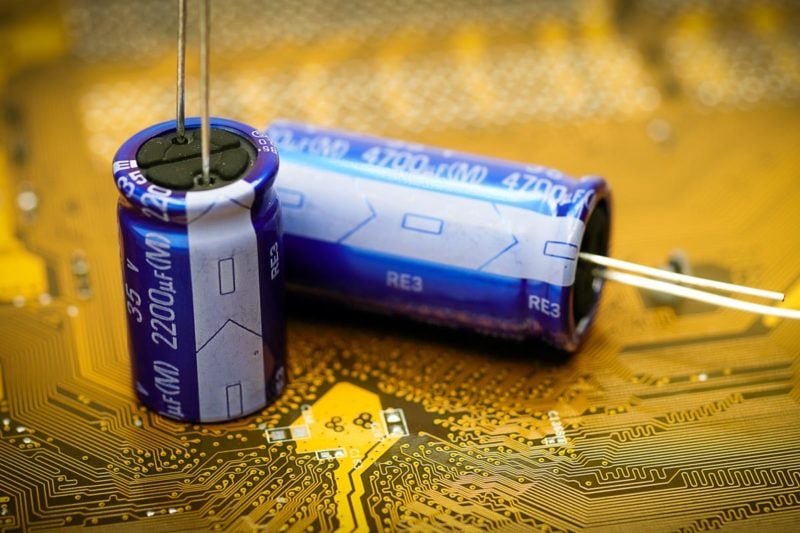How To Discharge An Ac Capacitor
Capacitors are mutual components in modern day electronic devices. They shop a charge that can be released at one time to components that need it. Capacitors can likewise exist used to filter specific betoken frequencies. When building, repairing or salvaging electronics, you can be certain of encountering them.
Before working on electronics, it is essential to first discharge any capacitors. Large capacitors (typically used in things like switched-mode power supplies, amplifiers, microwaves and HVAC equipment) tin can agree enough of a charge to injure or impale you, even if the device has not been plugged in for a while.
In this article, I will explicate the best manner to safely discharge capacitors, share the virtually ordinarily used tools and give yous the do's and don'ts. By the cease, y'all should have a practiced idea of how to handle capacitors without danger.
Let'due south swoop in!
Capacitors can be extremely dangerous! The content in this commodity is for informational purposes only. Whatever actions you undertake based on this data are your own responsibility.
Why practise capacitors need to be discharged?
Capacitors are capable of property onto charges for long periods of time. Especially if their circuit does not contain a 'bleeder' resistor that gets rid of that electric charge when the device is powered off.
If you come into contact with the terminals of a charged capacitor, the accuse can pass through your torso. Sometimes this tin even happen over a modest distance, like when your fingers are close to the terminals and the charge arcs over.
Depending on the energy in the capacitor, this can lead to a slight tingling, stupor, burns, and in the worst case, decease. The latter happens when the current passes through your heart and stops it.
Which capacitors are nigh dangerous?
It is of import to signal out hither that capacitors themselves do non pose any danger. Instead, information technology is the charge they contain that tin cause harm. Empty capacitors are always prophylactic. This is why the goal of this article is to teach y'all how to discharge a capacitor.
That said, sure capacitors exercise agree more charge than others, and because of that you should be more careful with capacitors that are capable of holding large amounts of energy.
There is no easy rule for the amount of energy that can cause (lethal) damage, because there are also other factors that matter. For example, pare conductance, pare thickness, hydration levels and the surface surface area you touch on all play a role in how well current can travel through your body.
In practice, it is the loftier voltage, high capacity electrolytic capacitors that are typically found on the primary (AC) side of ability supplies that you lot should exist about aware of. These have the potential to cause serious harm when charged (which they often still are after a menses of non-utilize).

You will come across these a lot when salvaging electronic components from ability supplies, CRT TVs, guitar tube amps, and other wall powered electronic devices.
Modernistic electronic devices often contain ane or more than 'bleeder' resistors in their circuit that help drain capacitors after unplugging the device. Older electronics built before the 1980s don't have these, then pay extra attention when working on these devices.
The same goes for cheap Chinese electronics, where these types of resistors are often omitted to relieve on component costs.

Which capacitors are considered rubber?
Generally, capacitors rated up to around 50V are considered fairly safety. They tin can even so injure you lot, merely they exercise not have plenty potential to start significant conduction in your body and kill yous.
Something to watch out for, however, is that a capacitor rated up to 30V, for example, can still piece of work at higher voltages. And so the voltage rating alone does not tell yous the whole story.
Similarly, capacitors rated for a safe voltage but with a very large capacity all the same pack a lot of energy. Shorting out their terminals creates serious oestrus, sparks, and perchance an explosion that sprays electrolytic liquid around.
This does not happen with typical run-of-the-mill capacitors, but when yous start working with depression-voltage capacitors with capacitances of 1 mF / 1000 uF and above, this is something to be aware of.
The all-time arroyo
Until y'all know for certain that a capacitor has been discharged, the best approach is to care for every capacitor like it holds a unsafe charge.
While it is possible that the capacitor is safe to handle, you lot must measure the voltage across its terminals first to be sure. If information technology is charged, belch the capacitor using the steps below.
This approach is similar to handling firearms, where you should care for every gun equally if it were loaded.
How to discharge a capacitor
Discharging a capacitor comes downward to connecting a resistive load to the capacitor's terminals. This creates a path for the current to bleed through and allows the resistive load to convert the electrical energy into thermal energy.
Commonly used resistive loads are a ability resistor or a light bulb.
Another mutual way to drain capacitors is to simply brusk them past placing an insulated screwdriver across their terminals. When working with loftier voltage capacitors this can exist problematic, however.
The insulated screwdriver creates an extremely low resistance path, which lets a loftier current flow (recall Ohm's law, Five = IR, electric current is inversely proportional to resistance). A capacitor releasing all of its free energy that apace can be dangerous (sparks, fire, explosions, etc.). Instead of using a screwdriver, it is recommended to utilise a proper resistive load for discharging, and then that the amount of current that can menstruum is restricted.
Beneath I will describe the general stride-by-step process for rubber discharging of a capacitor, and after that I will share the most usually used resistive loads.
What you'll demand
Stride-by-step
- Disconnect any power sources from the capacitor and its excursion. It is of import that the capacitor is not actively beingness powered, otherwise discharging it would pose quite a claiming. If there is a power cablevision, unplug it from the wall outlet. Additionally, remove any batteries.
- Identify the capacitor(s) on the circuit board. The nearly dangerous ones are the aluminum electrolytic capacitors used for loftier voltages. They expect like cylinders with a metal tiptop.
- Turn the circuit board over to go access to the capacitor terminals. Avoid touching any exposed metal on the circuit board with your bare hands.
- Connect the leads of your resistive load to the terminals of the capacitor. There are some caveats hither, and so brand certain to check the corresponding section of the specific blazon of resistor that yous program to use.
- Give the capacitor time to discharge. This typically does not take more than a couple seconds.
- Take your multimeter and ready information technology to the highest voltmeter setting.
- Connect the multimeter probes to the capacitor terminals. Polarity is not important.
- Check the voltage reading on the multimeter screen. If the reading is not close to 0V, the capacitor needs more fourth dimension to discharge. Echo steps 4-8.
Y'all can also measure the voltage across the capacitor before discharging it to see if information technology really needs to be discharged. I usually skip this, because information technology takes about the same time as the discharging process.
Using a elementary resistor
When using a simple resistor to discharge capacitors, in that location are several things you have to keep in mind.
Summary:
Use a 2kΩ or 20kΩ 5W resistor and don't bear on the leads with your bare hands.
Proper insulation
Don't bear upon the resistor leads with your bare hands. Instead, you tin can utilise a pair of quality alligator clips to connect the leads to the capacitor.
Resistor value
When it comes to choosing a resistor for discharging capacitors, information technology is important to pay attention to both resistance and wattage.
Resistance
The smaller the resistance value of the resistor is, the more current flows, and the faster the capacitor discharges. Speed is not something nosotros are looking for, however, every bit we prefer to have our capacitors drain slowly and in a controlled manner.
To continue things safe, we want to adjust the value of our resistor based to the voltages we are working with. The higher the voltages, the higher the value of the resistor.
For most applications, something similar a 2 kΩ resistor is sufficient. When working with capacitors of >400V, nonetheless, you might want to use a resistor of 20kΩ instead.
Wattage
As for wattage, it is important that the resistor can bargain with the amount of power going through it. Your typical through-hole resistor is rated for 0.25 Watts, which is not enough for discharging capacitors.
The formula for calculating the power is P = 52/R, where P is power, V is the voltage of the capacitor and R is the resistance of the resistor.
Afterward doing the numbers, you will find that a resistor with a wattage of five Watts is nearly always sufficient for normally used capacitors
With a capacitor discharge tool
When using a capacitor discharge pen, you practise not accept to worry about things like resistor values. It usually tells you right on the box what size capacitors it can safely deal with.
Capacitor discharge tools are essentially still resistors, but they come with a nice set of insulated leads and one or more LEDs. The LED indicates when the capacitor is completely drained and removes the demand for manual measuring.
Because of the LED(due south), it can be of import to connect the discharge tool with the correct polarity. This means connecting the blackness lead to the capacitor cathode concluding (indicated by the "-" symbol on the capacitor body).
Instead of buying i, you tin also make your own capacitor discharge tool.

Using a light seedling
Some other mode of discharging a capacitor is through the use of a lightbulb.
- Simply have a 100W light bulb and screw it into a bulb socket with wires.
- Adhere i wire to each of the capacitor terminals. If the capacitor is charged, the bulb will light up.
- Concur the leads in place until the bulb stops glowing. The capacitor is discharged once the bulb has fully dimmed.
The principal benefit of using a lightbulb (as opposed to a plainly resistor) is that you have a visual indicator of the charge level in the capacitor.
With an insulated screwdriver
Equally mentioned to a higher place, sometimes people utilise an insulated screwdriver to belch capacitors. The use of an insulated screwdriver to discharge capacitors is non recommended. It can cause impairment to the capacitor, circuit board, power supply circuitry, and, most importantly, hurt yous.
FAQ
Can you lot discharge a capacitor with a multimeter?
No. A multimeter should only be used to mensurate the voltage across a capacitor. Connecting the multimeter probes to a capacitor in different modes than the voltmeter mode can lead to damage to the multimeter, specially on cheaper meters with lilliputian protection circuitry.
Will a capacitor discharge on its own?
Aye, capacitors lose accuse slowly over time. The rate at which this happens varies depending on several circumstances. Sometimes it takes minutes or hours, only it tin can also take hours, days or months.
Never assume a capacitor has discharged on its ain! Always measure its voltage.
How dangerous is a capacitor?
Capacitors by themselves aren't dangerous, but the charge they incorporate is. Large Ac capacitors can store charges that tin injure and fifty-fifty kill you past stopping your heart. They should be treated with extreme care.
Is it prophylactic to discharge a capacitor with an insulated screwdriver?
Technically, draining capacitors with a screwdriver is just 'safe' on capacitors that comprise a very small charge. But even on those information technology is better to use a resistor or capacitor discharge pen instead.
Does discharging a capacitor damage or ruin it?
Only if you short the terminals with something like pliers or a screwdriver. When using a proper capacitor discharge tool, there is no hazard of damage or ruining the capacitor.
Determination
Capacitors are found in many devices and can be chancy. Especially high voltage capacitors should be treated with extreme caution. You will run into them in sound amplifiers, microwaves, televisions, switched-mode power supplies, guitar tube amps and HVAC equipment, amongst others.
With the right tool it is easy to discharge capacitors safely. Resistors, light bulbs or off-the-shelf capacitor discharge tools can all be used to drain a capacitor. Screwdrivers or multimeters should non exist used for this purpose.
Source: https://clevercreations.org/how-to-discharge-a-capacitor/

0 Response to "How To Discharge An Ac Capacitor"
Post a Comment